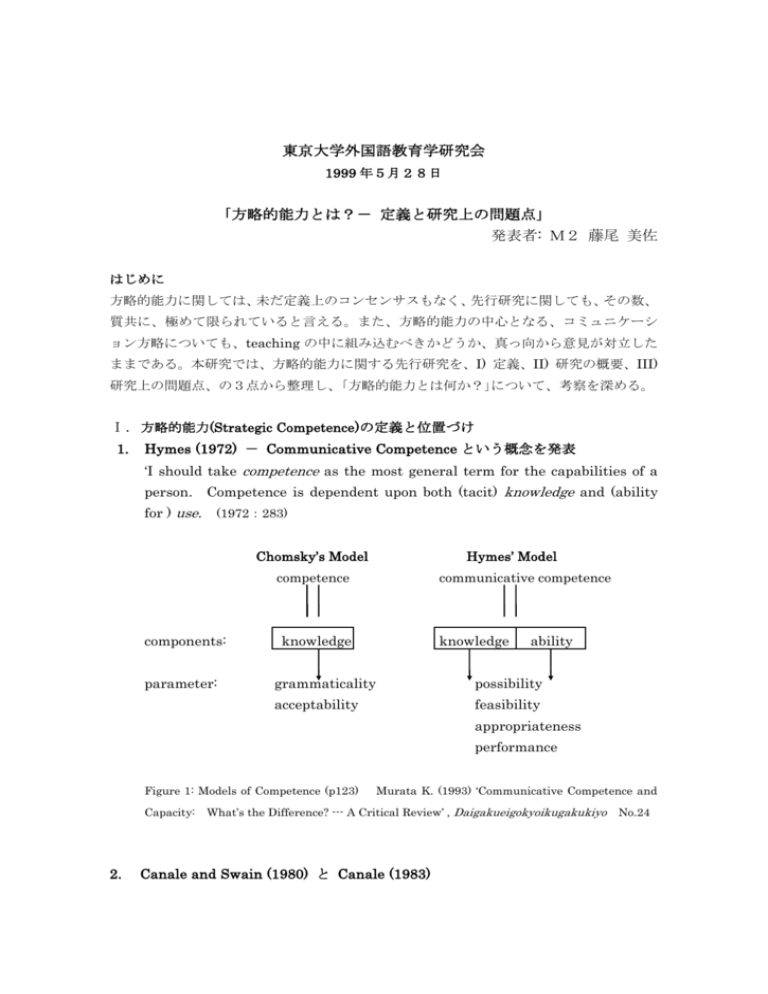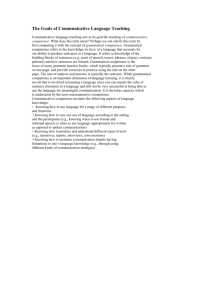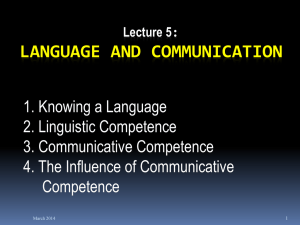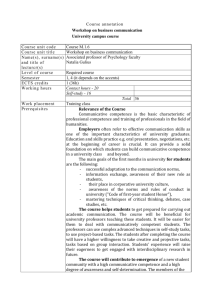第15回 マネジメント・コミュニケーション研究会
advertisement

東京大学外国語教育学研究会 1999 年5月28日 「方略的能力とは?- 定義と研究上の問題点」 発表者: M2 藤尾 美佐 はじめに 方略的能力に関しては、未だ定義上のコンセンサスもなく、先行研究に関しても、その数、 質共に、極めて限られていると言える。また、方略的能力の中心となる、コミュニケーシ ョン方略についても、teaching の中に組み込むべきかどうか、真っ向から意見が対立した ままである。本研究では、方略的能力に関する先行研究を、I) 定義、II) 研究の概要、III) 研究上の問題点、の3点から整理し、「方略的能力とは何か?」について、考察を深める。 I.方略的能力(Strategic Competence)の定義と位置づけ 1. Hymes (1972) - Communicative Competence という概念を発表 ‘I should take competence as the most general term for the capabilities of a person. for ) use. Competence is dependent upon both (tacit) knowledge and (ability (1972:283) Chomsky’s Model Hymes’ Model competence components: parameter: communicative competence knowledge knowledge ability grammaticality possibility acceptability feasibility appropriateness performance Figure 1: Models of Competence (p123) Capacity: 2. Murata K. (1993) ‘Communicative Competence and What’s the Difference? --- A Critical Review’ , Daigakueigokyoikugakukiyo Canale and Swain (1980) と Canale (1983) No.24 ‘communicative competence refers to both knowledge and skill in using this knowledge when interacting in actual communication.’ (1983:5) a) grammatical competence ( 文 法 的 能 力 ) - features and rules of the language such as vocabulary, word formation, sentence formation, pronunciation, spelling and linguistic semantic. b) sociolinguistic competence (社会言語的能力) - extent to which utterances are produced and understood appropriately in different sociolinguistic contexts depending on contextual factors such as status of participants, purposes of the interaction, and norms or conventions of interaction. c) discourse competence(談話能力)- how to combine grammatical forms and meanings to achieve a unified spoken or written text in different genres. d) strategic competence (方略的能力) - mastery of verbal and non-verbal communication strategies that may be called into action for two main reasons: (a) to compensate for breakdowns in communication due to limiting conditions in actual communication or to insufficient competence in one or more of the other areas of communicative competence, and (b) to enhance the effectiveness of communication (e.g. deliberately slow and soft speech for rhetorical effect.) 3. Bachman (1990) 言語能力と方略的能力の組み合わせで言語コミュニケーション能力 (communicative language ability)*1 が成り立つ。方略的能力を言語能力の中から 独立させ、各種下位能力の管制塔のような機能を持たせた。 ‘Communicative language ability (CLA) can be described as consisting of both knowledge, or competence, and the capacity for implementing, or executing that competence in appropriate, contextualized communicative language use.’ (1990:84) a) language competence (言語能力) - a set of specific knowledge components that are utilized in communication via language. b) strategic competence (方略的能力) - mental capacity for implementing the components of language competence in contextualized communicative language use. c) psychophysiological mechanism(心理生理的メカニズム)- neurological and psychological processes involved in the actual execution of language as a physical phenomenon. a) language competence (言語能力) 2 言語能力 Language Competence 編成能力 語用論的能力 Organizational C Pragmatic C 文法的能力 テクスト能力 発語内能力 社会言語的能力 Grammatical C Textual C Illocutionary C Sociolinguistic C b) strategic competence (方略的能力) ‘I view strategic competence as an important part of all communicative language use, not just that in which language abilities are deficient and must be compensated for by other means...’ 1) (1990:100) assessment component - determine the most effective and appropriate forms & structure. 2) planning component - retrieve items from language competence and formulates a plan whose realization is expected to achieve the communicative goal. 3) execution component - draw on the relevant psychophysiological mechanisms to implement the plan in the modality and channel appropriate to the communicative goal and the context. ‘Strategic competence is seen as the capacity that relates language competence, or knowledge of language, to the language user’s knowledge structures and the features of the context in which communication takes place. Strategic competence performs assessment, planning, and execution functions in determining the most effective means of achieving a communicative goal.’ (1990:107) c) psychophysiological mechanism(心理生理的メカニズム) 3 II. 方略的能力 or コミュニケーション方略(Communication Strategies)の研究概要 1. 初期の研究 - 主として定義と分類 a) コミュニケーション方略の定義 1) Tarone, Cohen and Dumas (1976) ‘a systematic attempt by the learner to express or decode meaning in the target language, in situations where the appropriate systematic target language rules have not been formed.’ 2) Tarone (1981) - interactional definition ‘a mutual attempt of two interlocutors to agree on a meaning in situations where requisite meaning structures do not seem to be shared’ 3) Faerch and Kasper (1983) - psycholinguistic definition ‘communication strategies are potentially conscious plans for solving what to an individual presents itself as a problem in reaching a particular communicative goal’ b). コミュニケーション方略の分類 1) Tarone (1981) - 添付参照 2) Faerch and Kasper (1983) i) Formal reduction strategies - 間違いや言いよどみを避けるため、完全に自 分のものになっていない表現(音素、文構成、語彙)を避ける ii) Functional reduction strategies - 問題を回避するため、意図した表現内容 を若干変更したり(topic avoidance)、一部削除したり、沈黙する(message abandonment)方略 iii) Achievement strategies - 何とか問題を解決しようとする方略 Compensatory strategies (代償方略) code switching (記号転換) interlingual transfer (言語間の干渉) IL based strategies (中間言語に基づく方略) generalization (一般化) paraphrase (言い換え) word coinage (造語) restructuring (再構築) cooperative strategies (協調の方略) non-linguistic strategies (非言語的方略) Retrieval strategies (復元方略) 4 2. 研究の転機 - The Nijmegen Project (1990) a) Definition of CS - ‘strategies which a language user employs in order to achieve his intended meaning on becoming aware of problems arising during the planning phase of an utterance due to (his own) linguistic shortcomings.’ b) Aims: 1) Investigate the relationship between CS use and the learners’ proficiency level, 2) c) d) Establish the relative effectiveness of particular CS types. Subjects - 3 groups of Dutch learners of English of different proficiency levels: 1) 15 second-year university students of English (advanced), 2) 15 fifth-grade secondary school pupils (intermediate), 3) 15 third-graders (low). Tasks: 1) to name or describe in English 20 concrete objects, 2) to describe 12 complex abstract figures, both in Dutch and in English, 3) to retell in English 4 one-minute stories told in Dutch, 4) to have a 15 minute interview on everyday topics with a native speaker of English. e) Analysis: 1) Conceptual - manipulation of the concept that they’re trying to convey, 2) Linguistic - resort to L1 or L2 and morphological creativity. Archistrategies Communication Strategies Conceptual 1. Analytic (circumlocution, description, and paraphrase) 2. Holistic (the use of a superordinate, coordinate, or subordinate term) Linguistic 3. Transfer (borrowing, foreignizing, and literal translation) 4. Morphological creativity f) Results: 1) L2-proficiency level predominantly affects the number of CS used, and has little effect on CS choice, 2) Task is a much more dominating factor with respect to CS use than proficiency level (greater variation in CS types in tasks 3) and 4)). 3) The comparison of L1 & L2 referential behavior failed to reveal any significant differences. 5 g) Observations - As to learner-characteristics, two factors might be relevant: focus on grammatical correctness and motivation to reach understanding. 1) Subjects who focus on grammatical correctness typically have long pauses when they are confronted with problems. Rather than solve problems, they tend to avoid them, 2) Those who were motivated to reach understanding used many strategies to overcome their problems. Very often they did not stick to a single CS, but tried different ones until understanding was reached. (Poulisse: 1990) 3. 90年代の研究 a) 特徴:1) divergence 2) recognition of L1 CS b) Pros & Cons (Yule & Tarone 1997) Pros Basic Attitude Cons profligate, liberal expansion of conservative, categories (Tarone,Yule) reduction parsimonious of categories (Bongaerts, Kellerman) Taxonomic reduction and achievement S compensatory Approach (Faerch & Kasper, Tarone) Description taxonomic observed description forms in L2 learner (Bongaerts,Poulisse,Kellerman) of description of underlying output, psychological process, internal external and interactive L1 CS (achievement)S and cognitive performance L2 learner compared to TL native speaker compared to performance their own L1 performance; many differences performance: many similarities found found Elicitation elicitation prompts prompts real-world objects Interlocutor listening partner, are elicitation prompts are abstract shapes with a no listening partner present purpose, present Type of L1 L2 learners with different L1s; L2 learners with same L1; L1s mostly dissimilar to TL L1 very similar to TL Pedagogical CS should be taught CS should not be taught issues (Dornyei, Tarone, Yule) (Bialystok, Kellerman) 6 III. 先行研究の問題点と今後の展望 1. 先行研究の問題点 The research to date has: a) concentrated almost exclusively on lexical problems, b) discovered little about the developmental nature of CS in L2 production, c) also made no attempt to investigate the relationship between the use of CS and acquisition, d) been limited to specific L1s e) not studied interlocutor-effects on the choice of CS 2. 今後の展望 In future studies, the following perspectives should be incorporated: a) grammatical, pragmatic problems other than lexical ones, b) the relationship between the use of CS and acquistion, c) sociocultural factors, d) learner’s variety e) the relationship with other strategies. Notes: 1. Bachman は Fundamental Consideration in Language Teaching (1990)の中で、 competence、ability 等の用語使用について以下のように述べている。 ‘I use knowledge and competence more or less synonymously, to refer to entities which we may hypothesize to be in the minds of language users. The term ability includes both knowledge or competence and the capability for implementing that competence in language use - ‘the ability to do X’. The term use and perform are more or less synonymous, referring to the execution, or implementation of abilities....’ <参考文献> 石井敏他編 (1996)『異文化コミュニケーションハンドブック』 有斐閣書店 垣田直己(監修)、岡秀夫(編) (1984)『英語のスピーキング』 大修館書店 酒井志延 (1991) 「英語のオーラルコミュニケーション能力を測定するテストの開発」 『STEP Bulletin』pp 59-72 日本コミュニケーション学会 橋本満弘、石井敏編 (1993) 『コミュニケーション論入門』 『日本人のコミュニケーション』『英語コミュニケーションの理論と実際』 桐原書店 馬場哲生(編) (1997) 『英語スピーキング論』 河源社 7 平野絹枝 (1985) 「日本人学生のコミュニケーション方略に関する一考察」『関東甲信越英語 教育学会紀要』1, 55-67 平野絹枝 (1987) 「教室内コミュニケーションの指導と評価」『中部地区英語教育学会紀要』 16: 190-195 平野絹枝 (1993) 「コミュニケーションにおける「態度」の指導と評価」『現代英語教育』6月号、 12-15 古田暁(監修)石井敏他(編)(1987)『異文化コミュニケーション』,有斐閣選書 本名信行他編 (1994) 『異文化理解とコミュニケーション』 三修社 松畑煕一、和田勝明著(1995) 『コミュニケーション能力の育成と評価』開隆堂 リチャーズ J.他編 (1988)『ロングマン応用言語学用語辞典』南雲堂 ロボ F. (1983) 『英語コミュニケーション論』大修館書店 Bachman L.F. (1990) Fundamental Considerations in Language Testing, Oxford: OUP Bachman L.F and Palmer A.S. (1982) ‘The Construct Validation of Some Components of Communicative Proficiency’ Brown, G. and Yule, G. (1980) TESOL 16-4 Teaching the Spoken Language, Cambridge: Cambridge University Press Brown G. and Yule G. (1983) Discourse Analysis, Cambridge: Cambridge University Press. Bygate, M. (1987)Speaking, Oxford:Oxford University Press Canale, M. (1983) ‘From communicative competence to communicative language pedagoty’, J. Richards & R. Schmidt (Eds) Language and Communication, Longman, pp2-27 Dornyei Z (1995) ‘On the Teachability of CS’ TESOL 29-1, pp55-85 Dornyei Z & Thurrell S. (1991) ‘Strategic competence and how to teach it’, ELT45-1, pp16-23 Ellis, R. (1984) ‘Communication strategies and the evaluation of communicative performance’, ELT38-1, pp39-44 Ellis, R. (1994) The Study of Second Language, Oxford: OUP Faerch C. & Kasper G. (Eds) (1983) Strategies in Interlanguage Communication, Longman Hymes D. H. (1972) ‘On Communicative Competence’, in J.B.Pride & J.Holmes Sociolinguistics, Penguin pp269-293 Johnson K. & Johnson H. (Eds) (1998) Encyclopediac Dictionary of Applied Linguistics, Blackwell , pp57-67 Murata K. (1993) ‘Communicative Competence and Capacity: What’s the Difference? - A Critical Reveiw’, Daigakueigokyoikugakukiyou No.24 Nakamura Y. (1993) ‘Measurement of Japanese College Students’ English Ability in a Classroom Setting’, Unpublished doctoral dissertation, ICU Poulisse N. (1990) ‘Variation in Learner’s Use of Communication Strategies’, in Duda & 8 Riley Leaning Styles: Proceedings of the 1st European Seminar pp77 - 87 Tomiyama M (1980) ‘Grammatical Errors Communication Breakdown’, TESOL 14-1, pp71-79 Yule G and Tarone E (1997) ‘Investigating communication strategies in L2 reference: pros and cons’, in G. Kapper and E. Kellerman (Eds) Communication Strategies, New York: Addison Wesley Longman Yule G and Tarone E (1990) ‘Eliciting the performance of strategic competence’, in R. Scarcella, E. Anderson & S. Krashen (Eds) Developing communicative competence in a second language, pp179-194, New York: Newbury House 9







